- Residents in Bolivia’s Sena community say that they can sell a jaguar canine for about $215 on the Chinese market.
- According to Bolivian authorities, the fangs are valued in the Asian market at prices as high as cocaine.
- Between 2013 and 2016, 380 jaguar canines were seized by Bolivian authorities, which correlates to 95 jaguars killed.
- Residents say an influx of Chinese companies to build roads and bridges in Bolivia is contributing to increased trafficking of jaguar parts. However, authorities deny these claims.
BOLIVIA — A skull rests in the hands of a hunter. It is a jaguar’s skull that has all of its teeth in place, except the four fangs that the jaguar used to sink into the necks of its prey – until Jesús shot him with an old shotgun in the Bolivian Amazon.
“For the tiger, you have to aim at the heart to leave it dry,” says the hunter, boasting of his aim.
Jesús, like many other hunters in the Bolivian jungle, usually uses the word “tiger” to refer to the jaguar (Panthera onca). He killed this particular jaguar in the thicket of a forest that he is very familiar with.

Jesús claims that he killed the jaguar three months ago because it was about to attack him, and that he shot it dead from about 30 meters away. He also says he would do the same thing again, because two Chinese citizens visited him in his home in Sena, in the Pando Department, to “open his eyes” and offer him $215 per fang. He also says that he sold them to them generously because he had never seen so much money in the same place. It surprised him that someone would pay so much money for a few jaguar fangs that were worth nothing to him.

Sena is a town in a corner of northern Bolivia, whose original inhabitants were of Tacana, Cavineño, Araona, and Ese Ejja origin. Between a small church and a karaoke bar called Calamina, a man named Jesús holds up the skull of a jaguar that he killed. He is unaware that Bolivian laws punish those who kill wild animals listed as “Vulnerable” by The Red Book of Threatened Vertebrate Fauna of Bolivia with up to six years in jail.
Jesús was unaware that the price of jaguar fangs, just like Bolivian cocaine, is worth 10 times more in China’s markets. He also didn’t know that the illegal hunting of the jaguar is threatening populations in forests in the Chaqueña Region, in the Bolivian lowlands,and in the northern Bolivian Amazon. These are places where the jaguar has always fought for its existence. For decades, jaguars have had to escape the bullets of hunters who kill them for their fur, which is highly valued in international markets. Jaguars have also lost habitat to increases in the agricultural, forestry and ranching industries.

Now, the jaguar has a new enemy. Until 2014, the trafficking of its fangs was a silent phenomenon in the communities of Santa Cruz, Beni, La Paz, and Pando, close to jungles and parks where the animals live. The jaguar is being pursued by networks of Chinese traffickers, in coordination with some Bolivians, in order to kill the animal and take its fangs, testicles and claws. In some Chinese markets, jaguar testicles are valued at the price of gold and are said to increase men’s sexual well-being and cure diseases that traditional scientific medicine cannot alleviate.

The jaguar fangs are also wanted for aesthetics. In China and other Asian countries, people wear fang pendants on their necks as a symbol of status and power. This is known by the government and ecological authorities in China.
The presence of a mafia in Bolivia that is encouraging the killing of jaguars, and of a growing Chinese market that fuels the trafficking of their products, is no longer a secret for the Vice Minister of the Environment and Water nor for the General Directorate of Biodiversity and Protected Areas. It is also known by forest police, the National Post Office of Bolivia (Ecobol), the directors of some natural parks, and another municipal office for communities near an area from where jaguar parts are trafficked. The epicenter of the trafficking is Trinidad, which is in Bolivia’s Beni Department, and reaches the Sena community in the Pando Department.
This group of institutions and authorities has made a series of recent discoveries. Between 2013 and 2016, the General Directorate of Biodiversity and Protected Areas, with the help of forest police and Ecobol, seized a total of 380 jaguar fangs. This correlates to the deaths of at least 95 jaguars. Evidence of trafficking has been found in Rurrenabaque, San Borja, Santa Rosa, and Reyes in the Beni Department, as well as the airports in Santa Cruz and La Paz. These airports serve as exit points to China. According to Rodrigo Herrera, a wildlife specialist from the Directorate of Biodiversity, a jaguar’s four fangs, 10 claws, fur and genitals fetches between $2,000 to $3,000 in China. In Asian markets, the price can reach $20,000. This price is comparable to cocaine trafficking; in Bolivia, one kilogram of cocaine is worth about $2,500, but can reach a value of $25,000 in international markets.

A declaration of war
Teresa Pérez, Director of Biodiversity and Protected Areas, is leading a fight against the traffickers and those who encourage the killing of the jaguars. In 2014, she began her efforts after an investigation revealed that demand from China was leading the trafficking.
Pérez conducted a raid on the home of a Chinese citizen in the tourist town Rurrenabaque, which she believes eliminated one of the main traffickers of jaguar fangs. However, she says she was not supported by the judicial system, whose judges and prosecutors, according to Pérez, made much of the evidence that may have incriminated the traffickers disappear.
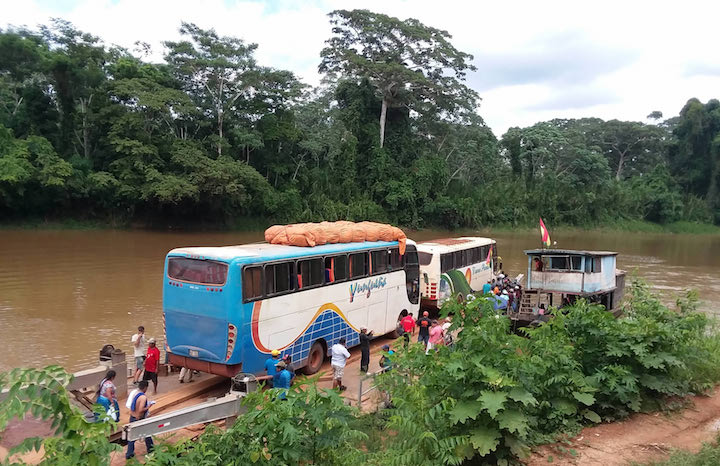
Rodrigo Herrera, who also works with Pérez, says that the computer and graphic material seized from the Chinese citizen in Rurrenabaque have disappeared. This leaves Pérez and Herrera with doubts about the judicial system, or at least about the chain of custody of those pieces of evidence. “We have a copy that, strangely, we were prevented from showing in the court that followed the case,” Herrera said.
However, the Minister of the Environment and Water set up 14 criminal proceedings against eight Chinese citizens and two Bolivians. They were confronted with products from jaguars they had killed before they were mailed to China.

Additionally, there was a criminal proceeding against a Bolivian woman who encouraged the hunting of jaguars through social media. There were also proceedings against two speakers on the radio, one in Reyes and one in San Borja, who promoted the sale of wild animal parts and offered money in exchange for “tiger fangs.”
The laws sing
Law 1333 of the Environment, and Article 223 of the Political Constitution of the State, have been enforced more strongly since 2013. This is when it was discovered that jaguars were being hunted for their fangs, claws and fur.
The first indications of trafficking began to appear in the form of flyers stuck on walls and poles in towns close to Amazonian nature reserves. There were also advertisements that let Indigenous and farming communities know that “tiger fangs” were being bought in good condition for good prices. Through these messages, traffickers invited interested people to come to certain lodging accommodations and ask for “such a person” to make the transaction.
Over radio stations in Rurrenabaque and San Borja, similar announcements were broadcast that were discovered by the Directorate of Biodiversity. The Directorate decided to take immediate measures and prosecute the owners of the stations for allowing the messages to be broadcast. On Dec. 11, 2014, a proceeding was begun against the Eco radio station in Reyes, and on Sept. 20, 2017, a complaint was formalized against the station “The Voice of the Farmer” of San Borja.
During an interview at the radio station “The Voice of the Farmer,” half a block from the main square of San Borja, press manager Erwin Escalante said that he is aware of the laws that protect wildlife. He said that one morning, a person arrived to ask if they wuold issue a statement encouraging the killing of jaguars. “But we did not broadcast that text. The trial really calls my attention, and the situation really worries me,” Escalante said. He also stated that in San Borja and surrounding areas, “it’s normal that jaguar fangs are commercialized, along with the fangs of other animals.”

The traffickers
Encouraging the killing of jaguars through radio broadcasts is only one of the methods used by traffickers. Within this ring of trafficking, there are also small buyers who are dedicated to going through rural communities asking if “anyone has tiger fangs,” tempting residents with money.
Marcos Uzquiano is the interim director of Madidi National Park in San Buenaventura in La Paz Department. Uzquiano remembers that he once followed a woman from San Borja who was known to buy fangs and maintain ties with Chinese citizens. He followed her through various towns until stopping her in Ixiamas, in La Paz Department. He brought her to a prosecutor, and she admitted that she had fangs in her possession.
“She pulled out five objects and put them on the table. The prosecutor asked me what the crime was for taking fangs from an animal. I filed the formal accusation, but she was released within 24 hours and they returned her phone to her, where she had photos of skulls and fangs that she had sent to a Chinese citizen who, according to her, works for one of the companies that is constructing the San Ignacio-El Sena Highway,” said a visibly angry Uzquiano.
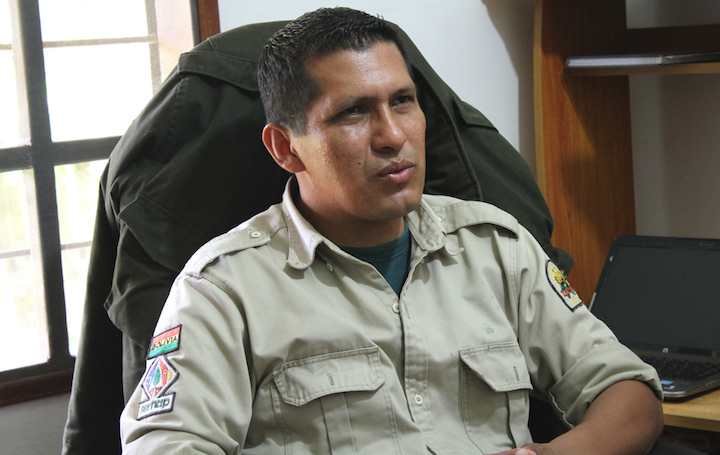
Authorities from the Directorate of Biodiversity have denied that the Chinese citizens who traffic the jaguar fangs have any relation to the companies building highways and bridges between Trinidad and towns in the Pando Department. However, various hunters, Indigenous leaders, and farmers from Santa Cruz, Beni, and Pando agree that the demand for fangs has increased greatly since the Chinese companies responsible for the construction began to arrive in the area.
Ángela Núñez, a biologist who specializes in wildlife conservation and management, agrees with this idea. She alerted international media that she believes that due to the growing trade links between Bolivia and China, a large number of Chinese citizens are promoting the illegal hunting of the jaguar and creating illegal trafficking networks.


International concerns
Núñez told the BBC that she began to notice the problem when she worked at the General Directorate of Biodiversity and Protected Areas in the Ministry of the Environment. Since leaving the position in 2015, she has been dedicated to confronting trafficking.
Núñez estimates that 140 jaguars have been killed to satiate the demand of Chinese markets, and that the problem is most apparent in Madidi National Park.
Evidence supporting this claim includes the discovery of 300 jaguar products, in 16 shipments, seized by the Bolivian postal service since 2014. All the shipments were destined for China, and 14 of them were sent by Chinese citizens working in Bolivia.

In the camp of a company that is constructing a road, a Chinese worker agreed to comment on this issue. “We don’t buy them now; it’s been many years. I believe that three years ago some Chinese people did, but not anymore; it’s prohibited. [Those who work in] the environment have told us that we can’t buy them, and that it’s [a] grave [offense]. Not now.”
A Bolivian citizen who was also in the camp and worked for the company defended the Chinese citizens working on the road. “It’s more the hunters who come to offer [the products], but they do not buy them because it is prohibited.”
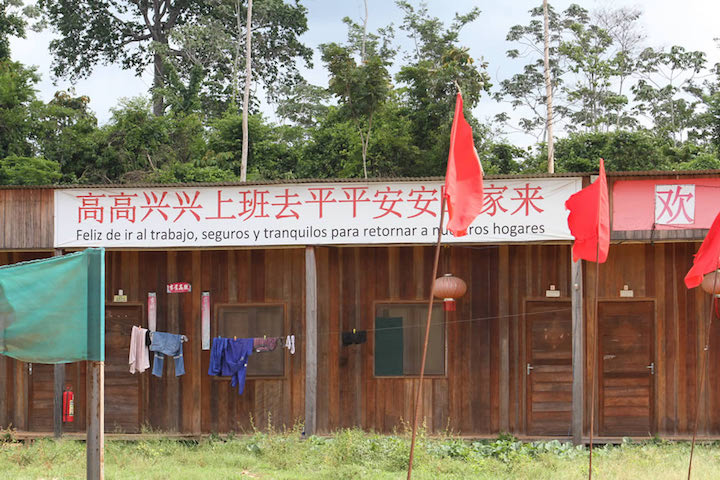
Rubén Laime, Director of the Environment in the Riberalta municipality, is an invited guest at an ecology fair organized by an educational center. His goal there, just like at various other environmental educational programs, is to raise awareness about the importance of the wildlife in the Amazon.
Laime speaks of hunting in general: the hunting of deer, reptiles, monkeys, snakes, and turtles in order to sell them in the markets of Riberalta. He knows that in years past, jaguars were killed simply for their fur. Only recently did he learn about the networks of traffickers who kill them for their fangs to sell in China.
Laime feels as though his hands are tied. He says he is a lone ranger who can do little for poaching. His greatest regret is that there are not any forest police in towns surrounding the jungle who could perform operations to stop the trafficking. He has tried to work with management and with the civil guard, but says that very little has been accomplished.
Few police
Laime isn’t mistaken. The forest police were nowhere to be seen when reporters visited Riberalta in 2017. The only ones there seem to be are stationed hundreds of miles from Riberalta, in Trinidad, the capital of Beni Department. An in general, there are very few forest police; of the five officers who were once dedicated exclusively to combating the trafficking of wildlife, only two remain. Those two officers cover an extensive territory, which lacks transportation routes and is now travelled by traffickers who see collecting jaguar fangs as a profitable activity.
In other communities in Bolivia, like San Borja, San Ignacio, Rurrenabaque, San Buenaventura, Reyes, Santa Rosa, Sena, and in the Yata, residents report not seeing forest authorities for some time.
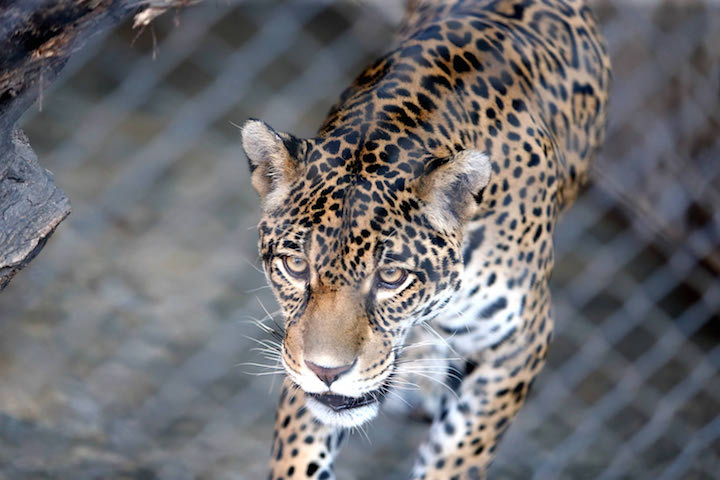
For all of Bolivia’s 424,164 square miles, there are only 50 police officers in charge of protecting wildlife. They are not assigned to provinces, but instead to the capital cities of the nine departments, according to Wálter Andrade Sanjinés, the director of the Forest and Environmental Police of La Paz.
Fortunato Pachacopa, who is responsible for the environment in Rurrenabaque, has been disappointed by the lack of forest police in his municipality. He knows that Law 1333 allows him to fight against the trafficking of wildlife and the sale of their products.
However, it’s impossible to change the world with only a law. Pachacopa says he has had little support in trying to do his job. He recalled how on one Sunday last year, he tried to confiscate various wildlife products that were being sold at a fair. “They almost lynched me. This thing is serious; people live off of this. They bring armadillo meat [and meat] from [other] wild animals. I found wallets made of jaguar, lizard belts, and armadillo and wild pig meat. I didn’t find jaguar fangs because I know that they now export them. I tried to explain to them that the law prohibits it, but they almost hit me. I had to quit what I was going to do. They are fed up and they are organized in associations,” Pachacopa said.
Pachacopa’s voice is calm, but he gestures resolutely as if he is going to get up and look for the traffickers.
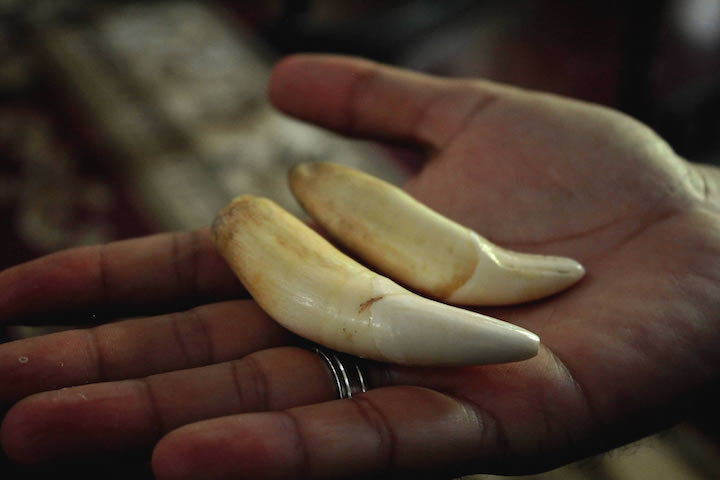
The voice of an accused
Pachacopa knows that the Minister of the Environment is following a judicial process against a Chinese citizen accused of buying fangs from hunters. “They say that he was trafficking parts of an animal. I found out when people from the Ministry of the Environment arrived on Nov. 17,” Pachacopa said.
Jabín is the name of the accused Chinese citizen. In Rurrenabaque, people say many things about Jabín, both good and bad. They say he is a man who lives off the business of trafficking jaguar fangs, who encouraged the killing of animals and offered good money to hunters and rural community members living in Madidi. They also say that Jabín has spent years doing this illegal activity, and that he was arrested and jailed for a few months. When he was released, he moved to a neighboring town in the Amazon.
Since learning that Jabín was in trouble with the law, restaurant owners in Rurrenabaque have disposed of the skulls, skeletons, and furs of wild animals that were being used as decorations on walls and counters. Ms. “Choca,” who owns a restaurant that Jabín frequented, has also taken precautions. The other day, when a hunter came to her door to offer a jaguar product, she said she stopped him in his tracks.
Jabín’s true name is Jian Fang Xiao. Uzquiano, the interim director of Madidi National Park, has put together an operation seeking to jail him. Now that Uzquiano is freely defending himself, he hasn’t taken his eyes off of Jabín.
Jabín lives in San Borja, a town in the Beni Department where the legal process against him is currently taking place. He resides in a rented house that includes an adjoining restaurant near the town’s edge.
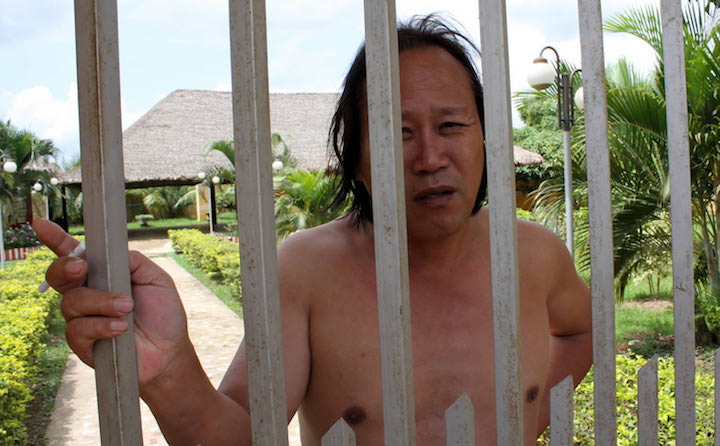
From inside a gate that overlooks a garden, Jabín says: “I don’t want to know anything. Right now we’re still in the trial. I don’t want to talk to anyone now. I am calm, all calm.”
“Is it true that you sell jaguar fangs to China?”
“I do not sell fangs,” Jabín said.
“And do you buy fangs from hunters?”
“Never. People just talk, that’s all. They talk, nothing else,” Jabín said.
“How long have you lived in Bolivia?”
“15 years,” Jabín said.
On the mafia’s trail
Sanjinés, the director of the Forest and Environmental Police of La Paz, has custody of 200 fangs, most of which were found in envelopes being sent to China. The senders gave false addresses such as Cochabamba and Santa Cruz.
To investigate the traffickers, Andrade shares intelligence with informants. He discovered that some traffickers trap and then shoot the jaguars, and that, right there in the middle of the jungle, they pull out their fangs with knives and pliers.
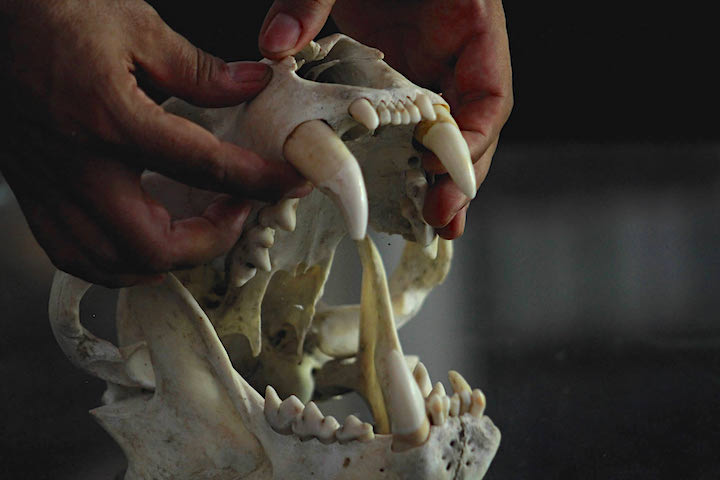
Andrade knows that the trafficking of fangs has changed from “modus operandi,” and is not as open and clear as it was a few months ago, when the transactions were advertised over the radio. “Now, this doesn’t occur anymore. Now they do it with more caution,” Andrade said.
Teresa Pérez, the Director of Biodiversity and Protected Areas, is preparing a “true blow” to disrupt the large network of traffickers, thanks to all the information that has been collected in recent years. “We have identified this network. There are [Bolivian] nationals and Chinese involved,” she said.
Sent by mail
Willma Pérez, of Bolivia’s postal service, Ecobol, also is doing her part in the fight. Between March 15 and Nov. 11, 2016, she found 181 fangs that were being sent in envelopes and packages to China. They were camouflaged in keychains, necklaces, rings, and boxes of chocolate. “When a suspicious envelope is found, we call the forest police and they come and confiscate it,” Pérez said.
Pérez also said that in 2017, there was not a single confiscation from the mail. This worries her because it suggests that the traffickers are no longer sending the fangs through Ecobol, but that they are now using other ways to transport the illegal products.
Public enemy
Vincent Vos is a Dutch citizen who has lived in Riberalta for 16 years. He is an investigator and environmental advocate who loves to observe jaguars when he goes into the jungle. He says he admires their powerful appearance, their fur, and their elegant walk that seems to suggest they are immortal.
Vos is aware that the jaguar is now being pursued for its fangs. This problem adds to the historically bad relationship between jaguars and ranchers, who hunt them under the pretext that they attack their heifers. Many ranchers work in areas where the jungle once reigned, where there were no cattle grazing in the meadows.
Four cowboys ride past on the side of the road from San Borja to San Ignacio. They are guiding a group of cows, bulls and calves. One of them has a shotgun that, according to him, is not loaded. “With it, I’ve killed a lot of jaguars,” he says. He makes a dull noise with his mouth to emulate the sound of an accurate shot.

He explains that jaguars have a habit of attacking heifers and killing them with their sharp teeth and claws. The jaguars then eat their prey near the farms. He says they know that the cowboys have revenge on their minds: they hunt jaguars not only with guns, but also with dogs trained to detect their scent. “We spend up to three days to find them, surround them, and eliminate them,” the cowboy said. “The dogs do their work and we do too; for them, it’s a feat.”
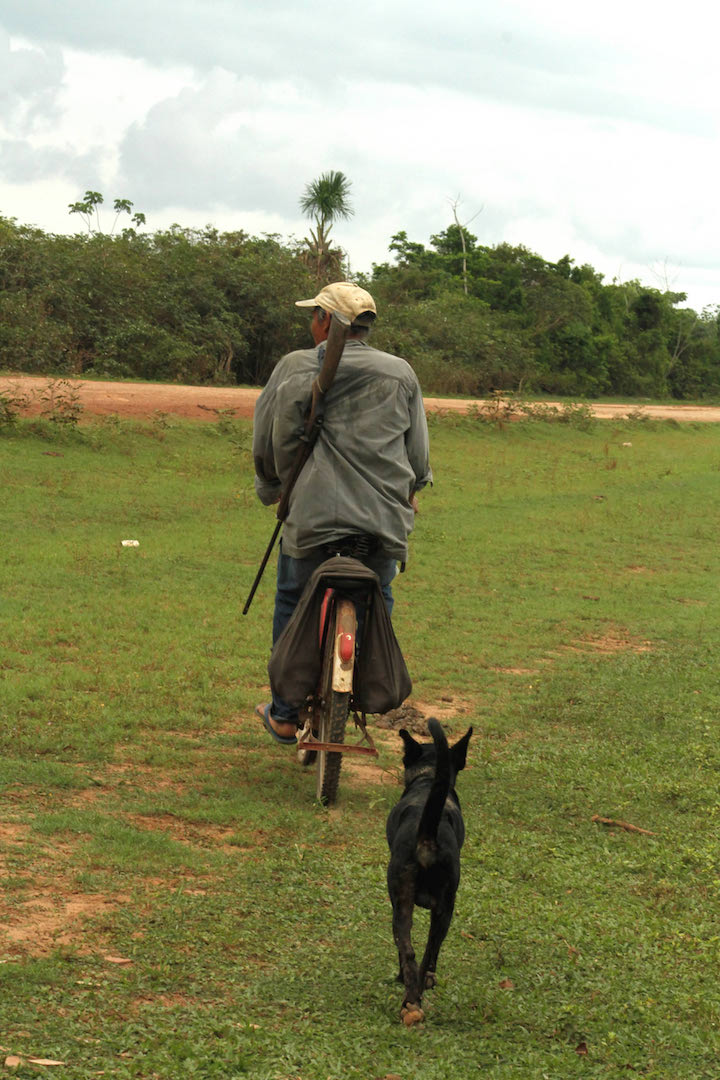
His job is to shoot when the jaguar is in front of him. After the jaguar is killed, farmers and hunters are content. The farmer is avenged, and the hunter gets the trophy: the jaguar’s four fangs and body, with its fur and claws that can be sold at the price of gold in the Bolivian Amazon.
This story is the result of a journalistic collaboration between Mongabay Latam and Bolivia’s El Deber. It first appeared in Spanish on Mongabay Latam on Jan. 15, 2017.
FEEDBACK: Use this form to send a message to the editor of this post. If you want to post a public comment, you can do that at the bottom of the page.

